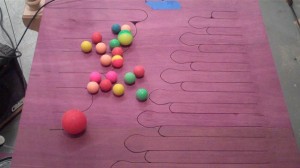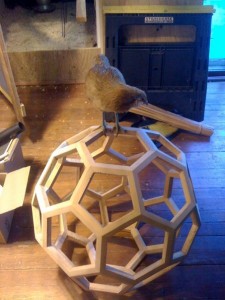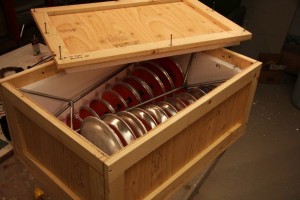When Music and Art Collide

On Friday, April 30, 2010, my ensemble, Great Noise Ensemble, will present the last concert of our 2009-10 concert season. The program, presented at Ward Hall, on the campus of the Catholic University of America at 7:30 p.m. (Visit www.greatnoiseensemble.com for tickets if you’re in the Washington region this Friday), is a unique program featuring a new work for mixed ensemble and sculpted percussion by composer D.J. Sparr in collaboration with artist Terry Berlier of Stanford University. The 41st Rudiment, named after the 40 “rudiments” that percussionists study as they develop their craft, represents one more rudiment indicative of the experimental nature of Berlier’s instruments. It was written for percussionist Christopher Froh, of the San Francisco Contemporary Chamber Players, and Great Noise Ensemble.
D.J. Sparr initially pitched the piece that would become The 41st Rudiment to Great Noise Ensemble’s board some five years ago. “The idea came through wanting to work with Chris Froh,” he says, “whom I had seen out on an amazing concert in Ann Arbor years back. I was in the Bay Area, so we went out for drinks, and over the course of the conversation we talked about finding instruments at a hardware store… and somehow, collectively we came up with the idea that we should ‘build something.’ From there, we started talking about what that would be, who might be interested collaborating with us, etc.” After searching for an appropriate collaborator it was Froh who suggested that they work with Terry Belier. “Terry and I worked on another project together a few years ago with the Empyrean Ensemble and Italian composer, Luciano Chessa. I played one of her sculptures then (an earlier “panlid gamelan”) and fell in love with her aesthetic. When D.J. and I first started talking about this project some five years ago, I suggested asking Terry to be involved.”
“A few years ago,” writes Terry Berlier, “ I was working on a piece called ‘Two pan tops can meet’ (2003) which was based on the homophobic Jamaican saying ‘Two pan tops can’t meet.’ (I had worked in Jamaica for two years as a Peace Corps Volunteer from 1995-97.) That first piece used thrift store pan lids as speaker housings that played a sound piece. But while I was sifting through the pan lids, I started setting aside the pan lids that resonated strongly. These eventually became Pan Lid Gamelan I in 2003 and gallery viewers were invited to play it.
In 2008, Composer Luciano Chessa wanted to compose this sculpture/instrument into one of our collaborations (Inkless Imagination IV) and I was excited to have a professional percussionist, Chris Froh, play them. A few years later, Chris asked if I would like to work with him again on making sculptures specifically for him to play and work with D.J. Sparr.”
D.J. Sparr has been building a reputation for many years now as a composer of rhythmically charged and energetic music (the Alburquerque Tribune once referred to his piece for eighth blackbird, The Glam Seduction as “Paganini on coke”) that merges classical conventions with rock idioms. The 41st Rudiment is no different, although the rock influence this time is far subtler than in the works that gained Sparr his early reputation. “I am always influenced by the drama of a rock-and-roll concert, and in this work, the drummer is the superstar… he engages the other players in ways to entice them to join in with him in gestures and call-and-response melodies…much the same as would happen in a rock-band scenario where guitarists, drummers, and bass players trade solos. This work,” however, “is heavily influenced by the baroque concerto grosso form as the large scale form is comprised of many short movements. There are elements of Bach and Vivaldi, but there are also elements of other things: Satie Gymnopédies; Spanish barcaroles; improvisatory structures such as Zorn’s Cobra; and many cadenzas and improvisation.”
Improvisation is a large part of The 41st Rudiment thanks to Christopher Froh’s input, who says that, while he plays “a lot of different varieties of new music across the spectrum. Although, San Francisco has a strong avant-garde tradition[1] and I often find myself playing very conceptual music. I also love to improvise, however, so the freedom in this version of the score will be a lot of fun to explore.”

Terry Berlier’s instruments for The 41st Rudiment are themselves stars. While the Pan-Lid Gamelan was the first sculpture made for this particular project (based, as we’ve seen, on an earlier work of Berlier’s) the other instruments represent a conceptual conjunction of music and art. “The Stairdrum was influenced by the South American instrument the cajón and a conductor’s podium. I was particularly interested in combining these two different objects together for their disparate differences in hierarchy. In part to bring the elitism of the conductor down a notch or two, while uplifting the grassroots drum, historically associated with slaves of West and Central Africa, primarily in Peru. The cajóns were often disguised as stools to avoid the Spanish colonial ban on slave music. In this case, the drum is disguised as a conductor’s podium which is able to be unassembled and assembled during the performance.”
Perhaps the most unusual instrument of the three is the Truncated Icosahedron Percussion Ball. Berlier says that it “began in an effort to make a more performative sculpture for a percussionist to play. I initially conceived it as an unpredictable and chaotic object that would roll around as it was being played. I wanted musicians to be more physical in there interaction with this object. The tubes coiled inside resonate when the outside face is slapped. Each sound hole, or hexagon face, outlets at its opposite side, allowing for variations in pitch.”
The 41st Rudiment, Presented at Ward Hall on the campus of The Catholic University of America, 620 Michigan Ave. NE, Washington, D.C. at 7:30 p.m. on Friday, April 30, 2010. Featuring three world premieres: “City Life” by Ian Hartsough, “Looney Tunes” by Robert Paterson and “The 41st Rudiment” by D.J. Sparr with artwork by Terry Berlier. Visit www.greatnoiseensemble.com for more information.
[1] An interesting dichotomy, how the East and West coasts seem to have switched musical aesthetics over the past several years. This may bear exploring on a later blog post…

Love this post. Looks like this will be an amazing concert and I’m very happy that I’ll be there.